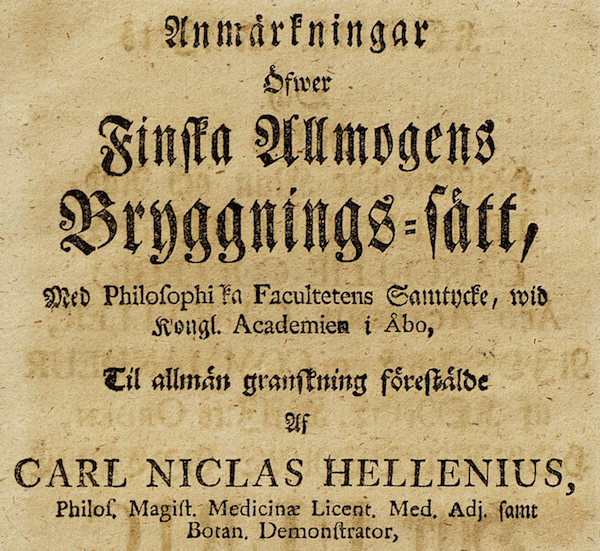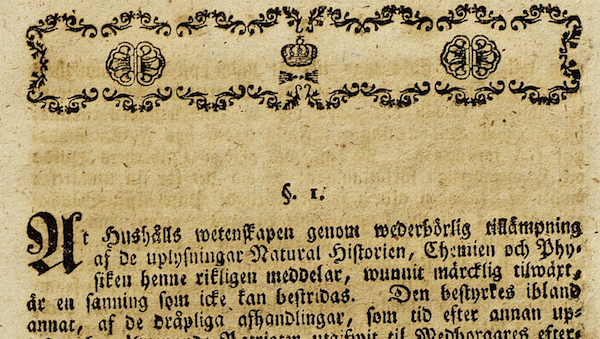The Campaign Against Raw Ale
It's April 5, 1780, at "the usual time in the morning". In the upper lecture hall of Åbo Academy, Carl Niclas Hellenius is preparing to give a talk. He is a researcher in natural history working at the Academy, and about to present the results of his investigation into "the brewing methods of the Finnish commoners". We know this, because his treatise has been preserved, and is today the oldest known description of the brewing of sathi.

Carl Niclas Hellenius |
The first section begins: "That the science of housekeeping through careful use of the information natural history, chemistry, and physics has so richly given her has won a powerful addition, is a truth that cannot be denied." The next pages are filled with similar stuff: awkwardly expressed pious twaddle of little interest to anyone. One can only imagine Hellenius's listeners squirming on the benches, wishing the smartphone had been invented.
Then, suddenly, section three begins: "For a righteous brew, there are several circumstances to observe." There follows a careful description of how the Finns brew their beer, which they call "olu". He says the mash is done first in cold water over night, then by successive additions of boiling water, until pulling the mash spade through the mash becomes easy. Then the mash is left alone and stones are heated in the fire until they glow, when they are thrown in the mash, which is carefully stirred. The mash is covered, so that it can be brought to a boil more easily.
A straining vessel is made ready, the bottom covered with straw and something unreadable. The mash is poured into this. A little hops is boiled in water separately, for an hour and a half, then added to the straining vessel. The wort is run off, but as long as it's cloudy it's poured back into the vessel. Finally, clear wort comes out, and is cooled until dipping your elbow in it feels cool. Then the yeast is stirred into the wort. Once that's done, the fermentation vessel is covered up so that it will stay warm.

The title page of Hellenius's article on sahti brewing |
So far, so good. What Hellenius describes is very similar to how Norwegian maltøl is brewed, and nearly identical to some present-day sahti methods. But Hellenius has not done all this work merely to describe how the Finns brew. His goal was actually set out in the first sentence: he wants to apply 18th century science to brewing, in order to improve it, as he makes clear in the next paragraph.
It begins: "Among the most important errors that in their beer brewing require correction is undeniably that they don't boil their wort." Hellenius says both malting and boiling are done to separate the "gluey and sticky" substances in the grain, so that they can be "dissolved, and give the sweet flavour" which is desired. He doesn't know about starch, sugar, and protein in those terms, but he has some idea of what is going on.
He also disapproves of the stones. "How many kinds of stones are there not, which when they glowing are extinguished in water [...], not only split asunder but also leave a taste behind?" He says they change both flavour and aroma. He also complains that the Finns take no care in which rocks they choose, and says they after the boiling are often ground to pieces or even turned into gravel in the bottom of the tun.

The beginning of the text |
Further: "If we find again what mass of insects nature has lodged on the hops [...] and how these have been able to dirty the hops [...] then politeness requires that before boiling the hops should be at least rinsed, which not a little should contribute to the clarity of the drink."
He's also worried that brewers add the yeast when the wort is either too cold or too warm. He says if the wort is too cold the fermentation is slow, and "the drink sours." If the wort is too warm the beer becomes more intoxicating (he claims) and gets an unpleasant flavour. This, he says, "in truth causes a greater detriment to their health than they can easily imagine".
The best sign he's learned from experienced female brewmasters is that when you dip a finger in the wort, you should feel a cold ring around the finger, even if the rest of the finger feels a warmth. He adds: "But how many circumstances can not contribute to the uncertainty of this sign? He would therefore make himself most deserved of our respect, who could contrive a test so certain that neither seasons nor other circumstances could affect it." He wants, in short, a thermometer. (The thermometer was developed in the early 17th century; in 1724 the Fahrenheit scale was proposed, in 1742 that of Celsius.)
But why is Hellenius so concerned with brewing and the "errors" the Finns make? This is made clear toward the end. He says the Finns lack of knowledge and poverty cause them not to make the best use of their resources for food and drink, which "thus becomes among the main causes to that most of the commoners die before they reach the age that nature has decreed for them. Can any circumstance in the science of houskeeping require more tender consideration, in a country sparsely peopled, than this? [...] Enlightenment and correction of the Finnish commoners' preparation of food and drink will undeniably be one of the surest means to keep up the mass of the population."
In short, Hellenius thinks making the Finns boil their wort will contribute to solving the underpopulation of Finland. It is to avoid this and other lethal errors in their brewing that he has undertaken his study. Fast-forward 235 years, to the present day, and we find that many sahti brewers still don't boil their wort. Hellenius must be rotating in his grave.
Interestingly, this was just the first volley in the campaign against raw ale. Preparing for the Norwegian farmhouse ale trip I found a piece in a local newspaper about a course in modern home brewing, attended by traditional home brewers. Most of them don't boil their wort. "It's a bad habit they have, this, not boiling their wort," says the instructor to the journalist afterwards. "Nobody else on earth does it this way. To make the beer bitter and remove the protein it has to be boiled." People asking about the home brewing of raw ale in home brewing forums are met with skepticism. And so on.
Having tasted quite a few raw ales by now, I find that I disagree entirely. Raw ale keeps poorly, but the best ones are sublime beers, absolutely excellent. So I think it's time we end this campaign, and my guess is that before very long, raw ale is going to be seen as just another variation on the subject of beer. If lambic is OK, there's no reason why raw ale cannot be.
Similar posts
Was all beer sour before Pasteur?
It's often said that before Pasteur's work on yeast (and Emil Christian Hansen's introduction of the pure-yeast system) all beer was sour
Read | 2014-10-26 18:01
How stone beer was brewed
It's only the last few centuries that metal kettles have become something that most people could afford to own
Read | 2016-12-18 12:47
Comments
Maltainen - 2015-01-14 13:02:20
Nice story Lars!
Many present-day sahti brewers think that boiling detracts the nourishing and protein rich qualities of sahti. Personally I feel that when wort that has been boiled, sahti loses some of its exoticism and becomes more like a standard beer.
I'm pondering about the use of hops in the description. What I have read and heard from present-day sahti brewers, bitter taste of hops is not valued in sahti. For example, In Asplund's Sahtikirja (a Finnish book on sahti) there is a story of a brewer who wants to use hops because of their preservative qualities but dislike the bitter taste. For this reason he boils the hops in water and then use only the hops discarding the water. Of course, present knowledge tells us that this renders the hops useless.
Lars Marius - 2015-01-14 14:05:43
@Maltainen: Thank you.
Well, there's no denying boiling takes some of the protein and nourishment out of the beer. Whether that's a bad thing in an age where people struggle with overweight is debatable, I guess.
That the protein and other effects of not boiling are a major part of the character of the beer I fully agree with. It's the same with the Norwegian and Lithuanian raw ales.
It's seems to be the same thing with hops in Norwegian maltøl: the bitterness is not really what they're after. To the degree that they want it they seem to mostly get it from the juniper instead.
I don't think Hellenius's account should be taken to mean that sahti brewers used more hops in the 18th century. He says literally that they use "one fistful" of hops per "kappe malt flour". A "kappe" seems to be 5.5 liters, so that's not a lot of hops, particularly as I assume Finnish native hops are not very bitter (or aromatic).